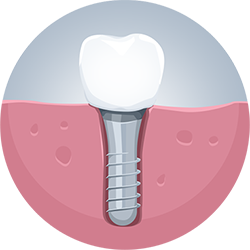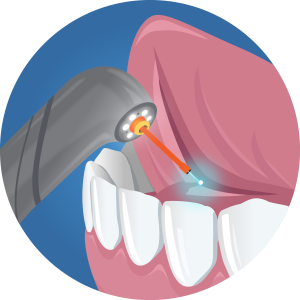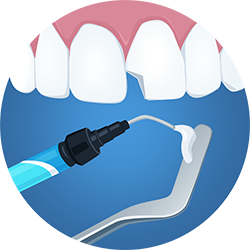
Implantation
Implantaadi konsultatsioon on TASUTA*
- A titanium screw
- An abutment, i.e. a connector
- A porcelain crown
What is the cost of replacing a tooth at Läänemere hambakliinik?
Läänemere hambakliinik offers everyone a free consultation regarding the installation of an implant. The price for all stages and components of an implant is EUR 1399. This price also includes injections, x-rays, diagnosis and recommendations. If for some reason the combined price is higher than the abovementioned price (for example, there is a need to augment the bone), our expert in this area will let you know about this in advance at the stage of a free consultation.
How is the procedure implemented?
As a rule, it takes 3 to 4 months from the installation of a titanium screw to seating of the permanent crown. During this period, three visits are required. The second and third visits do not require anaesthesia, because the manipulations are simple and painless.
- Installation of the implant is done under local anaesthesia, in compliance with all the aseptic and antiseptic rules. The procedure is painless and very well controlled. The implant is connected to a healing abutment or a temporary crown for the formation of the profile of the emergence of the future permanent crown. After that, the process of healing, i.e. osseointegration, starts. The waiting time is 3 months.
- Impression taking, i.e. contouring of a pattern, is performed; the colour and material of the structure are chosen.
- The crown is seated.
Will the implant take root?
The osseointegration process, i.e. the implant survival, has been studied very well. The phenomenon was first described in the 1960s, and in the last few decades there has been no more doubt about the high success rate of the procedure. The success rate of implant integration in Läänemere hambakliinik is more than 99%.
What is the lifespan of the implant?
The implant has the best survival rate among all types of prosthetics. According to a recent systematic review, a 15-year survival rate of the implant is 95%.
Int J Oral Maxillofac Surg. 2015 Mar;
Evaluation of survival and success rates of dental implants reported in longitudinal studies with a follow-up period of at least 10 years: a systematic review.
Moraschini V1, Poubel LA2, Ferreira VF3, Barboza Edos S4.
Are there any absolute contraindications to implant therapy?
No. There are relative contraindications, which are usually temporary because the modern implant therapy has the necessary tools to prepare the patient for the safe installation of the implant through a combination of special measures, while minimizing the associated risks.
My doctor told me that I have too little bone. Do I qualify for implant dentistry?
Yes, you do. First of all, the bone deficit has to be verified clinically and radiologically. If the issue is confirmed, there are hard tissue augmentation techniques, i.e. restoration of the bone volume, which will prepare you for the safe installation of the implant.
What can I expect after the installation of the implant?
After the implant is installed, you will feel a minimal discomfort around the area of surgery. Usually, a slight pain in the gums lasts for 2 to 3 days. You will not have to take a leave from work, as the microsurgical techniques help avoid a painful response of the soft tissue and speed up the healing process.
I have a one-piece removable denture, and it doesn’t hold well. What should I do?
We can stabilize your denture with 2 to 4 implants using special ball attachments. Please contact us for a consultation and we will help you!
Hammaste implanteerimisele eelnevad seotud protseduurid
- Treatments (General dentistry)
- Implantation
- Teeth extraction
- Microscope-assisted root canal treatment
- Paediatric dentistry
- Frenectomy of the tongue and lips
- Orthodontics
- Laser dentistry
- Periodontitis treatment
- Prosthodontics
- General anaesthesia
- First aid
- Professional cleaning
- Veneers
- Composite fillings
- LED whitening
- Home whitening
- Treatments (General dentistry)
- Implantation
- Teeth extraction
- Microscope-assisted root canal treatment
- Paediatric dentistry
- Frenectomy of the tongue and lips
- Orthodontics
- Laser dentistry
- Periodontitis treatment
- Prosthodontics
- General anaesthesia
- First aid
- Professional cleaning
- Veneers
- Composite fillings
- LED whitening
- Home whitening




